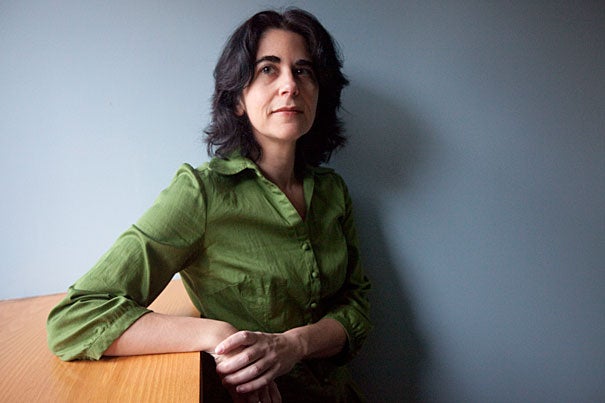
“I grew up in California, first in San Francisco’s Haight-Ashbury district and then in a nearby suburb much like the one in which ‘Life in Miniature’ is set,” said lecturer Linda Schlossberg. “I was one of those kids who was always reading, which I think gave me a good understanding from an early age of how voice and character work.
Kris Snibbe/Harvard Staff Photographer
Troubled youth
Coming of age shadowed by mother’s mental illness in debut novel
“My mother hasn’t gone to the grocery store for a few weeks — it just keeps slipping her mind, she told us — so for the last few nights we’ve been putting together meals based on whatever we can find in the cabinets and the back of the refrigerator,” says Adie, the narrator of Linda Schlossberg’s affecting debut novel, “Life in Miniature.”
Born three months premature, Adie is smaller than most girls her age. When her single mother, Mindy, suffers a nervous breakdown, a neighbor cares for the 12-year-old Adie and her teenage sister, Miriam, until Miriam runs off with a boyfriend to pursue a better life. The novel then traces Adie’s coming of age under the wing of an increasingly unhinged Mindy, who takes her on the run from motel to motel, trying to shake the drug dealers who she insists are closing in.
“I grew up in California, first in San Francisco’s Haight-Ashbury district and then in a nearby suburb much like the one in which ‘Life in Miniature’ is set,” said Schlossberg, a lecturer in the Committee on Degrees in Studies of Women, Gender, and Sexuality in the Faculty of Arts and Sciences, and assistant director of undergraduate studies.
“I was one of those kids who was always reading, which I think gave me a good understanding from an early age of how voice and character work. I really love coming-of-age novels, particularly when they are written from the point of view of the child, and that’s what I set out to do with my novel.”
Schlossberg said she worked on “Life in Miniature” “on and off for many years.”
“Many of my courses in WGS explore issues of mental health and illness, particularly as they pertain to women,” she said. “I knew I was interested in telling a story about mental illness, and I wanted to explore the way in which a paranoid personality might draw upon the larger cultural paranoia of her time — in this case, the cultural anxieties surrounding drug use and the whole ‘Just Say No’ culture of the early 1980s.”
Funny and perceptive, Adie buoys the novel with the insight her mother lacks. On a trip to the store, Adie says, “I think the fact that we’re shopping, out in public, makes my mother feel like our lives aren’t that unusual. After all, in a store, everyone looks normal.”
Said Schlossberg: “At first I wanted to tell the story from the mother’s perspective, but then I realized that I was most interested in figuring out how a child — with her limited diagnostic vocabulary and cloudy understanding of the issues at hand — would try to make sense out of a confusing and necessarily unstable situation.”
When she rereads the novel, Schlossberg said, she’s “struck by how surprised I still am by certain parts of it. One of the most pleasurable things about writing is that sense of not fully controlling it.”
“You would think that after spending so much time revising the novel I would remember every line, but some of them still sneak up on me,” she said. “But I do remember that I wrote the final chapter very quickly and liked it right away, that I immediately thought, ‘OK, that’s it, that’s how the story ends.’”




